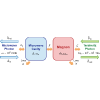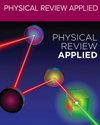Microwave-to-optical quantum transduction utilizing the topological Faraday effect of topological-insulator heterostructures
IF 3.8
2区 物理与天体物理
Q2 PHYSICS, APPLIED
引用次数: 0
Abstract
The quantum transduction between microwave and optical photons is essential for realizing scalable quantum computers with superconducting qubits. Due to the large frequency difference between microwave and optical ranges, the transduction needs to be done via intermediate bosonic modes or nonlinear processes. So far, the transduction efficiency via the magneto-optic Faraday effect (i.e., the light-magnon interaction) in the ferromagnet YIG has been demonstrated to be as small as due to the weak magneto-optic coupling. Here, we take advantage of the fact that three-dimensional topological insulator thin films exhibit a topological Faraday effect that is independent of the sample thickness in the terahertz regime. This leads to a large Faraday rotation angle and therefore enhanced light-magnon interaction in the thin-film limit. We show theoretically that the transduction efficiency between microwave and terahertz photons can be greatly improved to by utilizing the heterostructures consisting of topological insulator thin films, such as and ferromagnetic insulator thin films, such as YIG.

利用拓扑绝缘体异质结构的拓扑法拉第效应实现微波到光量子转换
微波光子和光学光子之间的量子转换对于实现具有超导量子比特的可扩展量子计算机至关重要。由于微波和光学范围之间的频率差异很大,因此需要通过中间玻色子模式或非线性过程来实现量子转换。迄今为止,由于磁光耦合较弱,在铁磁体 YIG 中通过磁光法拉第效应(即光磁子相互作用)实现的转导效率 η 已被证明小至 η∼10-8-10-15 。在这里,我们利用了三维拓扑绝缘体薄膜在太赫兹机制下表现出与样品厚度无关的拓扑法拉第效应这一事实。这导致了较大的法拉第旋转角,从而增强了薄膜极限的光磁相互作用。我们从理论上证明,利用由拓扑绝缘体薄膜(如 Bi2Se3)和铁磁绝缘体薄膜(如 YIG)组成的异质结构,微波和太赫兹光子之间的传输效率可以大大提高到 η∼10-4。
本文章由计算机程序翻译,如有差异,请以英文原文为准。
求助全文
约1分钟内获得全文
求助全文
来源期刊

Physical Review Applied
PHYSICS, APPLIED-
CiteScore
7.80
自引率
8.70%
发文量
760
审稿时长
2.5 months
期刊介绍:
Physical Review Applied (PRApplied) publishes high-quality papers that bridge the gap between engineering and physics, and between current and future technologies. PRApplied welcomes papers from both the engineering and physics communities, in academia and industry.
PRApplied focuses on topics including:
Biophysics, bioelectronics, and biomedical engineering,
Device physics,
Electronics,
Technology to harvest, store, and transmit energy, focusing on renewable energy technologies,
Geophysics and space science,
Industrial physics,
Magnetism and spintronics,
Metamaterials,
Microfluidics,
Nonlinear dynamics and pattern formation in natural or manufactured systems,
Nanoscience and nanotechnology,
Optics, optoelectronics, photonics, and photonic devices,
Quantum information processing, both algorithms and hardware,
Soft matter physics, including granular and complex fluids and active matter.
 求助内容:
求助内容: 应助结果提醒方式:
应助结果提醒方式:


